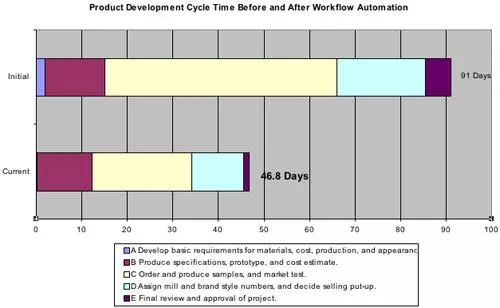Are your "evolved processes" bogging down your productivity? Todd takes a look at how Process Improvements or Technology, or both, may help you turn those evolved processes into "designed processes."

Virtually all of the projects we encounter at Todd Herman Associates (THA) link back to issues from what we call "Evolved Processes" – workflow processes that have evolved over time as staff or technology, or both, have changed. We have found that people, and consequently aggregations of people called "companies," do not always like change. So, processes undergo evolutionary change, rather than deliberate change. It's hard to give up what we know, what we're comfortable with – as a result, we don't always work smarter, because we're too busy adapting our current processes instead of dropping them altogether for new and improved processes.
The View From the Top ...
When we first meet with a client, we typically start out by discussing the issues the company is experiencing – what pain prompted them to call THA – with senior management. We get an overview of what they see as a problem, and try to find out where they think the causes exist.
... and From the Trenches
After we get a good overview from management, we then move on to other personnel – the people in the trenches carrying out the day-to-day processes – for more specific discussions. The interview frequently goes something like this:
- Consultant – "So, you receive the 'Prototype Description' form from Kevin in Marketing. What do you do next?"
- Client – "I rewrite the information onto our 'Prototype Work Order' form, so that we can keep tabs on it. And, I almost always call Kevin back to get additional information, because his form lacks a field to describe the packaging desired."
- Consultant – "Changing the form seems pretty easy – how long have you been calling him back?"
- Client – "About 3 or 4 years. After all those calls, you'd think the Marketing folks would add it to the form."
- Consultant – "Once you get the information from Marketing, what do you do next?"
- Client – "I fill in this one last space for Mary in Cost Accounting – but I really don't know why."
This dialog reveals what would generously be called an "evolved process" – one that has evolved without explicit design.
Process Improvement
What can be done to replace "evolved processes" with "designed processes"? Some suggestions include:
- Dig deep to understand the process – This requires asking questions, taking good notes, and gathering examples of various documents.
- Document the existing process at a high level – Since you are reviewing a process you know should be changed, spend a short amount of time on this task. This documentation provides a benchmark to judge proposed revisions.
- Estimate measures of existing process cost, cycle time, or quality – Since this is an "evolved process," no one will know exactly how it works or could be measured. So, establish some reasonable estimates – preferably, using measures that can be linked to overall business success.
- Define the desired process – Layout the forms and process flow for the proposed process. Keep in mind you will go through several revisions of both forms and flow before process participants are satisfied.
- Estimate measures of desired goals for process cost, cycle time, or quality – By using the same measures as for the existing process, you can document the expected improvements, and set goals for the implementation.
- Implement and troubleshoot – After preparing appropriate forms and procedures, and training relevant personnel, convert to the new process. No matter how thoroughly you performed the previous steps, users will identify additional improvements. Review these and implement them quickly to keep momentum strong.
- Measure the values achieved for process cost, cycle time, and quality – By establishing methods to measure and report these values against goals, you build a self-reinforcing mechanism for continued improvement.
Technology Usage
If you invest the effort to review and improve a major "evolved process," you should also consider automating the process. Automation comes in many forms:
- E-mail routing of information – This method is fine for simple or noncritical processes.
- E-mail routing of documents – A problem with this method is that documents attached to an e-mail message may need to be detached for completion – which requires the revised document to be re-attached before mailing it to the next user.
- Workflow "lite" application, with a database containing the information and email notification of tasks – This is good for processes with low to medium complexity, and medium to large quantities of data. Each person is notified, via email, when their work can begin, with a link taking them straight to the task.
- Dedicated workflow automation software – This is appropriate for any process, but is virtually required for highly complex or high-volume processes. Typically, all information is housed in a central database, a flowchart-like interface is used to visually define the process, and an email notice will be automatically sent to the affected person.
The last two techniques – which I call "workflow technology" – yield the greatest process improvements, because they eliminate transportation and waiting times, and enforce data completeness and accuracy at each step.
Likely Results
What kinds of results can you expect from your effort?
- Improving a process – without using workflow technology – can result in cycle time reductions of 10% to 20%.
- Improving a simple process and using workflow technology typically results in 20% to 25% cycle time reductions.
- Improving a lengthy or complex process and using workflow technology can yield at least 40% to 50% cycle time reductions.
Here's an example of the time savings we found for a client that designs and manufactures high quality apparel for a variety of customers (see the full story at Using Workflow Automation to Redefine Product Development).

Pulling It All Together
If you do all these tasks well, a wrap-up conversation may go like this:
- Consultant – "How is the automated process working?"
- Client – "It's going great! I get an e-mail notifying me when I have something to do, and I can go directly into the document requiring my time. It's good to know I have all the information I need to do my work – no more wasted time tracking down missing or inaccurate information. And, by cleaning up the process and forms, I only enter information that is truly necessary."
By identifying problem areas, eliminating bottlenecks, and automating some tasks, we can replace "evolved processes" with a new system standardizing processes and ultimately saving time and money! Call us if you'd like us to take a look under your hood.
Sincerely,
![]()
Todd L. Herman






